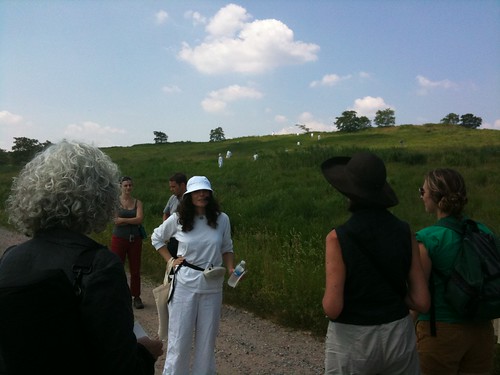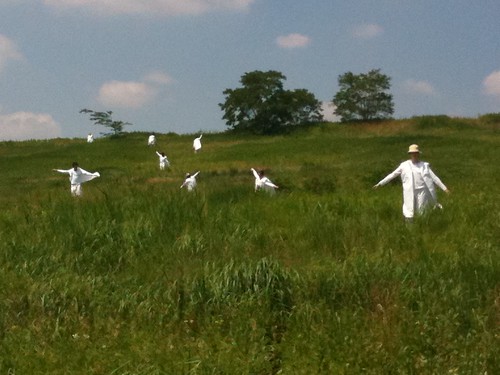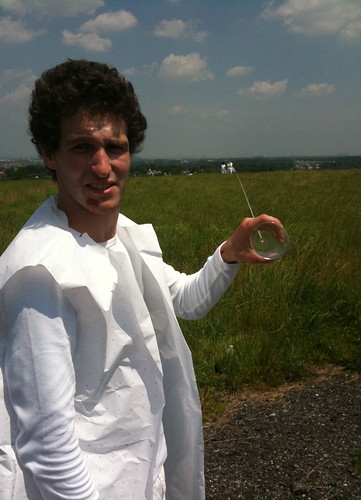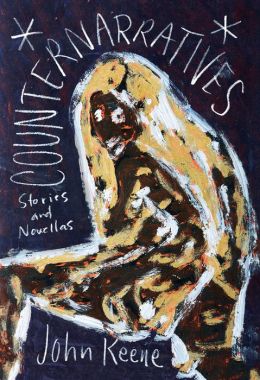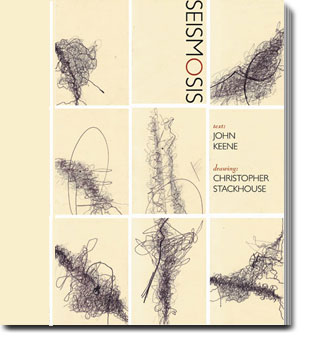Two summers ago I blogged about the first version of Park, a collaborative project that combined the talents of poet, scholar and translator Jennifer Scappettone, dancer and choreographer Kathy Westwater, and set designer Seung Jae Lee in creating a multimedia public, open-air performance at the Freshkills Park on Staten Island, which had once been the notorious Fresh Kills Landfill, the largest trash dump in the US. Yesterday, in lower Manhattan, Westwater staged PARK Scores @ LentSpace, a temporary public site at the intersection of 6th Avenue and Canal Street, right near the entrance of the Holland Tunnel and just at the edge of the now high-rent but formerly industrial Tribeca and SoHo neighborhoods.
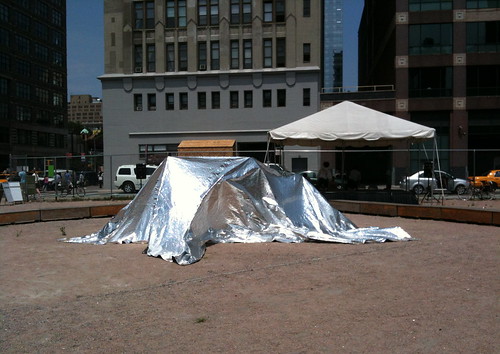
According to the press for the event, "In 2010 and 2011, at Fresh Kills Westwater created scores that respond to and evoke the experience of the site in its current liminal state -- no longer landfill and not yet parkland. Not unlike Fresh Kills itself, PARK scores continue to be re-imagined and remade beyond the iconic site, including now at LentSpace. Owned by Trinity Wall Street, LentSpace is licensed for use to Lower Manhattan Cultural Council for temporary art installations. It is also vacant land Occupy Wall Street attempted to inhabit after Zuccotti Park."
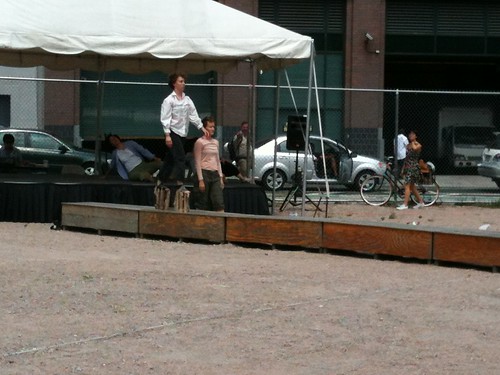
I was originallyunaware of the Occupy Wall Street connection with LentSpace, but I thought about it as I considered the environmental and ecoliterary aspects, of the performance. The 2010 performance had the vast, transformed spaces of the Freshkills Park at its disposal; LentSpace is far smaller and more enclosed, though it too, because of its provisional nature and multiple points of entry/exit, felt like a space that could and should be reconfigured in multiple ways, including improvisatorily, and the performance appeared to take this into account. Also, the earlier version required that the audience meet up in advance and take the ferry over to Staten Island, but this PARK score, however, had built into a far more transient audience. People could and did come and go as they pleased, some sitting through only a part of the performance, others staying as I did until the end, still others unwittingly (or perhaps they did realize what they were doing) walking through part of the performance space, which itself then became part of the performance.
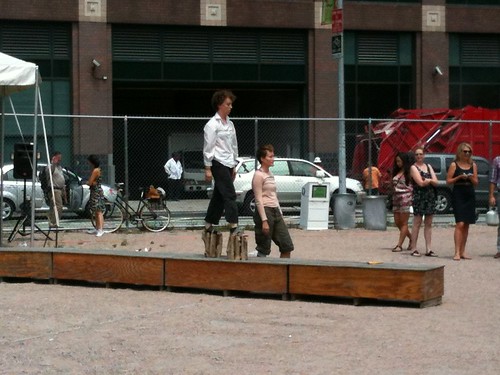
This PARK score, employing movement, play, and sound, utilized four distinct areas of LentSpace. There was the gravely arena, in which Westwater and the other dancers, in various combinations. worked with a large, silvery rectangle sheet of mylar (I think that's what it was), which became a cloud or clouds, or smoke or smog, or fog, or haze, or hills or mountains, or a lake or sea or ocean, or waves and tides, or a tent or buildings, or lungs or a heart or a stomach, or a ball or heap of garbage, or debris or anything else in any of the above places. There was a long, elevated bench, one of several ringing and enclosing the arena space, on which one dancer, first with the accompaniment of a second dancer beside her and then alone, walked on platform shoes made of tree stumps. I could only watch her intermittently as I kept praying she would not take a misstep and harm herself. The third space was a large table, draped with black cloth, on which several different combinations of dancers performed. This was hardest to see from where I stood, but eventually I walked around the ring space to see them up close. And then there was the open area around the performance sites. The musician, Shiraishi, took advantage of this and the possibilities of how the sound would carry, as he even walked through the crowd playing a piercing figure on his saxophone.

The performances made me think of so many things, including refuse and re-use, of capitalism, consumerist excess, appropriation and reappropriation and repurposing (including détournement), of the natural and the (human-)made, of text and context, of the body, the human and the post-human, and of process and continuous transformation within the context of art, and particularly dance, music, and performance, with their incredible capacity for presentation and representation, precision and ambiguity, ephemerality and resonance. I even thought of LentSpace itself, and of the city, changing and rapidly gentrifying, all around it. Out of something almost forgotten, but in private hands, something very temporary and offering a place of sociality and refuge had come into being, and, for one day, an even more specific and temporary event, a performance, had offered those present something quite special.


I was also much more aware of simultaneity and multiplicity as I stood watching, photographing and recording the performance: to give one example, there was the interplay between Shiraishi's music and the ever-changing ambient soundscape of workers, people eating lunch, the food trucks, the traffic and Tribeca and SoHo streets nearby; at the end of the one of the videos I'm posting below, you can hear what I consider to be one the signal urban sounds: a siren. It, like the performance, was a wake-up call, though nowhere near as interesting, or moving.

The participants: Choreography: Kathy Westwater; music: Tamio Shiraishi; poetry: Jennifer Scappettone; set: Jae Lee: performers: Hadar Ahuvia, Ilona Bito Tessa Chandler, Hilary Chapman, Belinda He, and Kathy Westwater, with Tamio Shiraishi on multiple analog and digital instruments.


According to the press for the event, "In 2010 and 2011, at Fresh Kills Westwater created scores that respond to and evoke the experience of the site in its current liminal state -- no longer landfill and not yet parkland. Not unlike Fresh Kills itself, PARK scores continue to be re-imagined and remade beyond the iconic site, including now at LentSpace. Owned by Trinity Wall Street, LentSpace is licensed for use to Lower Manhattan Cultural Council for temporary art installations. It is also vacant land Occupy Wall Street attempted to inhabit after Zuccotti Park."

I was originallyunaware of the Occupy Wall Street connection with LentSpace, but I thought about it as I considered the environmental and ecoliterary aspects, of the performance. The 2010 performance had the vast, transformed spaces of the Freshkills Park at its disposal; LentSpace is far smaller and more enclosed, though it too, because of its provisional nature and multiple points of entry/exit, felt like a space that could and should be reconfigured in multiple ways, including improvisatorily, and the performance appeared to take this into account. Also, the earlier version required that the audience meet up in advance and take the ferry over to Staten Island, but this PARK score, however, had built into a far more transient audience. People could and did come and go as they pleased, some sitting through only a part of the performance, others staying as I did until the end, still others unwittingly (or perhaps they did realize what they were doing) walking through part of the performance space, which itself then became part of the performance.

This PARK score, employing movement, play, and sound, utilized four distinct areas of LentSpace. There was the gravely arena, in which Westwater and the other dancers, in various combinations. worked with a large, silvery rectangle sheet of mylar (I think that's what it was), which became a cloud or clouds, or smoke or smog, or fog, or haze, or hills or mountains, or a lake or sea or ocean, or waves and tides, or a tent or buildings, or lungs or a heart or a stomach, or a ball or heap of garbage, or debris or anything else in any of the above places. There was a long, elevated bench, one of several ringing and enclosing the arena space, on which one dancer, first with the accompaniment of a second dancer beside her and then alone, walked on platform shoes made of tree stumps. I could only watch her intermittently as I kept praying she would not take a misstep and harm herself. The third space was a large table, draped with black cloth, on which several different combinations of dancers performed. This was hardest to see from where I stood, but eventually I walked around the ring space to see them up close. And then there was the open area around the performance sites. The musician, Shiraishi, took advantage of this and the possibilities of how the sound would carry, as he even walked through the crowd playing a piercing figure on his saxophone.

The performances made me think of so many things, including refuse and re-use, of capitalism, consumerist excess, appropriation and reappropriation and repurposing (including détournement), of the natural and the (human-)made, of text and context, of the body, the human and the post-human, and of process and continuous transformation within the context of art, and particularly dance, music, and performance, with their incredible capacity for presentation and representation, precision and ambiguity, ephemerality and resonance. I even thought of LentSpace itself, and of the city, changing and rapidly gentrifying, all around it. Out of something almost forgotten, but in private hands, something very temporary and offering a place of sociality and refuge had come into being, and, for one day, an even more specific and temporary event, a performance, had offered those present something quite special.


I was also much more aware of simultaneity and multiplicity as I stood watching, photographing and recording the performance: to give one example, there was the interplay between Shiraishi's music and the ever-changing ambient soundscape of workers, people eating lunch, the food trucks, the traffic and Tribeca and SoHo streets nearby; at the end of the one of the videos I'm posting below, you can hear what I consider to be one the signal urban sounds: a siren. It, like the performance, was a wake-up call, though nowhere near as interesting, or moving.

The participants: Choreography: Kathy Westwater; music: Tamio Shiraishi; poetry: Jennifer Scappettone; set: Jae Lee: performers: Hadar Ahuvia, Ilona Bito Tessa Chandler, Hilary Chapman, Belinda He, and Kathy Westwater, with Tamio Shiraishi on multiple analog and digital instruments.




